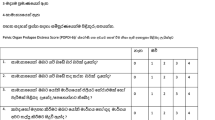Abstract
Introduction and hypothesis
The purpose of this study was to adapt the Pelvic Organ Prolapse Symptom Score (POP-SS) into Turkish and evaluate its reliability and validity.
Methods
The POP-SS was adapted into Turkish by following the steps of the intercultural adaptation process. One hundred and three women with symptomatic or asymptomatic pelvic organ prolapse (POP) completed the Turkish POP-SS and other valid and reliable Turkish tools for POP: Pelvic Organ Prolapse Distress Inventory 6 (POPDI-6), Colorectal–Anal Distress Inventory 8 (CRADI-8), Urinary Distress Inventory 6 (UDI-6), Pelvic Floor Distress Inventory 20 (PFDI-20), and Pelvic Organ Prolapse Impact Questionnaire 7 (POPIQ-7). Pelvic Organ Prolapse Quantification (POP-Q) system was also used to assess pelvic support, and patients were divided into three groups based on POP-Q scores. Cronbach’s alpha was used to determine internal consistency, and intraclass correlation coefficient (ICC) was estimated for test–retest reliability. POP-SS validity was assessed by using the Spearman rank correlation and Kruskal–Wallis analyses. The underlying scale structure was determined by exploratory factor analysis.
Results
The POP-SS scale had high internal consistency (Cronbach’s alpha = 0.705) and test–retest reliability (ICC = 0.981; p < 0.001). Among groups, there was statistically significant differences in POP-SS scores. POP-SS scores were also significantly correlated with POPDI-6 (r = 0.830), CRADI-8 (r = 0.525), UDI-6 (r = 0.385), PFDI-20 (r = 0.752), and POPIQ-7 (r = 0.690) (p < 0.001). Two factors were identified by exploratory factor analysis.
Conclusions
The Turkish version of POP-SS is a valid and reliable tool for Turkish women with POP.
Similar content being viewed by others
References
Ismail S, Duckett J, Rizk D, Sorinola O, Kammerer-Doak D, Contreras-Ortiz O, et al. Recurrent pelvic organ prolapse: international urogynecological association research and development committee opinion. Int Urogynecol J. 2016;27(11):1619–32.
Reid F. Assessment of pelvic organ prolapse: a practical guide to the pelvic organ prolapse quantification. Obstet Gynaecol Reprod Med. 2014;24(6):170–6.
Uysal-Bozkir Ö, Parlevliet JL, de Rooij SE. Insufficient cross-cultural adaptations and psychometric properties for many translated health assessment scales: a systematic review. J Clin Epidemiol. 2013;66(6):608–18.
Gjersing L, Caplehorn JR, Clausen T. Cross-cultural adaptation of research instruments: language, setting, time and statistical considerations. BMC Med Res Methodol. 2010;10(1):1.
Hagen S, Glazener C, Sinclair L, Stark D, Bugge C. Psychometric properties of the pelvic organ prolapse symptom score. BJOG Int J Obstet Gynaecol. 2009;116(1):25–31.
Kashyap R, Jain V, Singh A. Comparative effect of 2 packages of pelvic floor muscle training on the clinical course of stage I–III pelvic organ prolapse. Int J Gynecol Obstet. 2013;121(1):69–73.
Glazener C, Elders A, Macarthur C, Lancashire R, Herbison P, Hagen S, et al. Childbirth and prolapse: long-term associations with the symptoms and objective measurement of pelvic organ prolapse. BJOG Int J Obstet Gynaecol. 2013;120(2):161–8.
Hagen S, Stark D, Glazener C, Dickson S, Barry S, Elders A, et al. Individualised pelvic floor muscle training in women with pelvic organ prolapse (POPPY): a multicentre randomised controlled trial. Lancet. 2014;383(9919):796–806.
Beaton DE, Bombardier C, Guillemin F, Ferraz MB. Guidelines for the process of cross-cultural adaptation of self-report measures. Spine. 2000;25(24):3186–91.
Bump RC, Mattiasson A, Bø K, Brubaker LP, DeLancey JO, Klarskov P, et al. The standardization of terminology of female pelvic organ prolapse and pelvic floor dysfunction. Am J Obstet Gynecol. 1996;175(1):10–7.
Celenay ST, Akbayrak T, Kaya S, Ekici G, Beksac S. Validity and reliability of the Turkish version of the Pelvic Floor Distress Inventory-20. Int Urogynecol J. 2012;23(8):1123–7.
Kaplan PB, Sut N, Sut HK. Validation, cultural adaptation and responsiveness of two pelvic-floor-specific quality-of-life questionnaires, PFDI-20 and PFIQ-7, in a Turkish population. Eur J Obstet Gynecol Reprod Biol. 2012;162(2):229–33.
Barber MD. Symptoms and outcome measures of pelvic organ prolapse. Clin Obstet Gynecol. 2005;48(3):648–61.
Hagen S, Glazener C, Cook J, Herbison P, Toozs-Hobson P. Further properties of the pelvic organ prolapse symptom score: minimally important change and test–retest reliability. Neurourol Urodyn. 2010;29(6):1055–6.
Perneger TV, Leplège A, Etter J-F. Cross-cultural adaptation of a psychometric instrument: two methods compared. J Clin Epidemiol. 1999;52(11):1037–46.
Ercan İ, Kan İ. Ölçeklerde güvenirlik ve geçerlik. Uludağ Üniversitesi Tıp Fakültesi Dergisi. 2004;30(3):211–6.
Aksayan S, Gözüm S. Kültürlerarası Ölçek Uyarlaması İçin Rehber II: Psikometrik özellikler ve kültürlerarası karşılaştırma. Hemşirelikte Arastırma Gelistirme Dergisi. 2003;5:3–14.
Gutman RE, Ford DE, Quiroz LH, Shippey SH, Handa VL. Is there a pelvic organ prolapse threshold that predicts pelvic floor symptoms? Am J Obstet Gynecol. 2008;199(6):683.e1–e7.
Ghetti C, Gregory WT, Edwards SR, Otto LN, Clark AL. Pelvic organ descent and symptoms of pelvic floor disorders. Am J Obstet Gynecol. 2005;193(1):53–7.
Acknowledgements
The original Pelvic Organ Prolapse Symptom Score (POP-SS) was authored by Hagen et al. (2008) and is copyrighted.
Author information
Authors and Affiliations
Corresponding author
Ethics declarations
Conflicts of interest
None.
Rights and permissions
About this article
Cite this article
Özengin, N., Kaya, S., Orhan, C. et al. Turkish adaptation of the Pelvic Organ Prolapse Symptom Score and its validity and reliability. Int Urogynecol J 28, 1217–1222 (2017). https://doi.org/10.1007/s00192-016-3251-x
Received:
Accepted:
Published:
Issue Date:
DOI: https://doi.org/10.1007/s00192-016-3251-x




